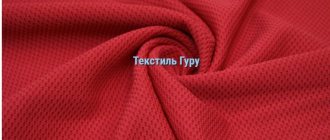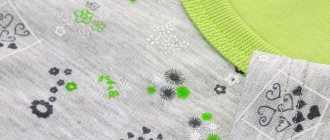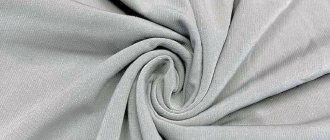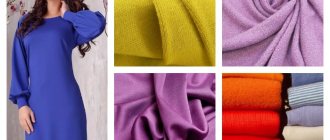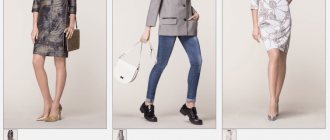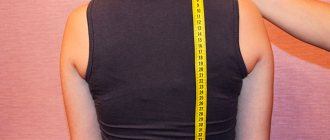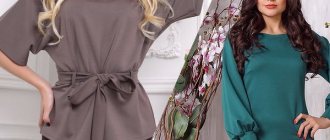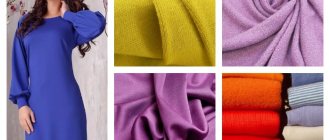We will talk about one of the most popular fabrics: French knitwear has gained a reputation as a reliable, comfortable and beautiful material. It can be used to make almost any clothing; stylish dresses, original tunics, elegant suits, formal trousers, trendy skirts and even summer coats are made from it. Models can be made in classic, office, vintage, glamorous, ethnic and casual styles.
Description and types
Women give high marks to the material. Items made from it do not require special care; the composition of French fabric and its texture satisfy fashionistas. They are also pleased that the material does not stretch, although there is stretch. By the way, after this, many people are interested in what kind of fabric this is - Italian knitwear.
French knitwear is made on the basis of artificial textured fibers, which means that the material is synthetic. Thanks to the uniqueness of the threads, it is dense and stretches well, but returns to its original shape. There are several types of French knitwear:
- Demi-season;
- Winter;
- Summer.
The difference is in the type of thread used.
Fabric care
Although French knitwear is highly resistant to wear and tear, there are several requirements for caring for the fabric. Compliance with them will allow you to preserve the appearance and properties of knitwear for a long time, even after numerous washes. It is also necessary to pay attention to the composition of the fabric fibers and select appropriate care.
Basic Rules:
- It is advisable to wash knitwear by hand at a water temperature of up to 40° C. When washing in a machine, you need to select the delicate or hand wash mode.
- Do not use products containing bleaches. It is recommended to use powders in liquid form.
- Dry at room temperature. First, lay the product on a horizontal surface on a soft, light-colored cloth, after the water has drained, carefully hang the item on the dryer. It is not advisable to overdry French knitwear and should not be dried in the bright sun.
- Iron at a minimum temperature, you can simply use a warm iron turned off. The more synthetic fibers a fabric contains, the lower the heating temperature should be. Before ironing, you can slightly wet the product.
Some customers complain that pilling appears on the fabric over time, especially in areas with the most friction. The cause of deterioration in appearance may be:
- long-term and frequent use of the item;
- improper care;
- strong friction during washing;
- high content of natural fibers;
- low quality of the fabric itself.
It is worth considering that high-quality French knitwear cannot be too cheap . Therefore, when buying a dress at a suspiciously low price, there is a high risk of purchasing a “one-time” item. If pellets do appear on the fabric, they can be removed with a disposable razor or a special machine for removing pellets.
Gallery: French knitwear (25 photos)
A little history
To describe any material, it is always useful to consider the history of its appearance. Oddly enough, people learned to knit threads later than to weave. There is isolated information that a knitted sock was found during excavations of ancient Egyptian layers. It is not confirmed in other sources. Apparently, the sock had a later origin. Perhaps it was lost by archaeologists.
French knitwear in blue tones
According to textbooks, knitted items appeared only in the 6th century AD. Now this seems strange because in archaeological museums we see ancient fishhooks. It would seem that if fishing hooks existed, then crochet hooks could also exist. History decreed otherwise. They started knitting with knitting needles. Many nations knitted simple clothes for the low-income population. Until the 16th century, knitting was done only by hand. In the 16th century, the first hand-loom for machine knitting was invented in England.
Knitted items became fashionable thanks to the great fashion designer Elsa Schiaparelli. She was Italian by origin and lived and worked in France at the beginning of the 20th century. According to legend, the sweater that impressed Elsa Schiaparelli was seen on an American sailor. According to other sources - on a friend. All sources indicate that he was tied up by an Armenian emigrant who lived nearby.
I liked the sweater because it did not stretch out and kept its shape well. As we now understand, it was knitted using the same type of knitting method that French knitwear is now made.
Little black dress
The fashion designer managed to present knitted products with special chic. They quickly gained popularity. This is how the legendary little black dress appeared, which subsequently conquered the whole world. It was knitted.
The modern name of the group of materials “French knitwear” appeared due to the fact that this particular type of knitting in France has gained unprecedented recognition. Then the passion for knitted products spread to other countries. French fashion in those days set the tone for fashionistas all over the planet. Nowadays machines are used to make knitwear.
This is interesting: Satori fabric: characteristics, description, areas of application
Classification
Matter can be classified into types based on weave:
- Interok . Durable and hygroscopic fabric. The base is 100 percent cotton. Smooth inside and outside. The material does not stretch, but after washing it may change slightly in size. With the inclusion of synthetic threads in the composition, the material will receive a fleece. Based on this material, clothes for home, work, and children are sewn.
- Ribana . A material containing rubber fibers, as well as viscose and polyester. Has high extensibility and elasticity. Products made from it perfectly fit the silhouette. Characterized by high resistance to the formation of arrows and puffs. Ribana is used for sewing home and holiday clothes, casual clothes and clothes for children.
- Kashkorse . This fabric is 95% cotton. It has excellent stretchability, but after prolonged wear it may lose its attractiveness. Various additives in the composition of the fabric make it possible to obtain fabric with or without fleece. Cashkorse is used to make children's and sportswear and bed linen.
What does it consist of?
French knitwear is suitable for creating warm dresses and underwear - why? The wide range of applications is due to the diversity of the material itself. Types of fabric with the required characteristics are obtained by adding synthetic and artificial fibers, as well as dyes.
According to its composition, French knitwear is divided into three categories (natural, mixed, and synthetic), which differ in both properties and external characteristics.
Advice! Knitwear with mixed fibers is best suited for making clothes.
Natural fabric is usually made from cotton. If it is 100%, the material is particularly soft. The thickest and warmest fabric is obtained by adding wool. This knitwear is denser and less breathable.
Mixed fabric is produced with the addition of synthetic fibers, usually polyester. This admixture increases the resistance of knitwear to deformation and wear. Those who have a negative attitude towards synthetics will like fabric with viscose fiber. Items containing elastane threads are characterized by a high degree of elongation and a specific shine.
pros
In addition to its high strength, knitwear has other advantages compared to other popular fabrics. The advantages include:
- The special texture of the thread does not allow it to lose color. Dyes are firmly embedded into the surface.
- A wide range allows you to obtain different clothing options based on the material: sophisticated underwear and warm winter clothes.
- A universal material that can be easily matched with accessories and wardrobe items.
- Excellent antistatic properties, which prevents the creation of static electricity.
Customer Reviews
I’m always short on time, so I switched to a wardrobe made of French knitwear, listening to my friend’s feedback. An excellent way out of the situation: no need to iron, no need to be afraid of wrinkles. I washed it, dried it, put it on – that’s it! Natalya V., 37 years old, Samara
Author:
Zakharova Nina Afanasyevna
I hope you like my article! If you find any shortcomings, just write to me about it! I am always ready for a conversation and will answer any questions you have, ask them!
